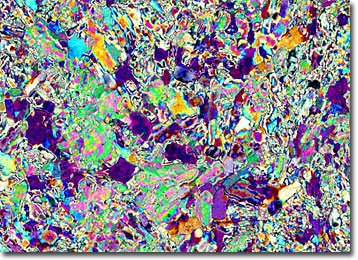Polarized Light Microscopy Digital Image Gallery
Anhydrite
First identified in Innsbruck, Austria, anhydrite is a relatively common rock-forming mineral. The name of the substance, which is primarily found in arid locales, fittingly stems from the Greek words for “without water.”

Anhydrite does not form directly from geologic processes, but rather occurs as water evaporates from the mineral gypsum. Both minerals are composed of calcium sulfate, but gypsum’s water loss results in a reduced volume of the rock in which it is contained, sometimes leading to the formation of caverns or grottos. Common in evaporites, anhydrite frequently can be found capping salt domes, such as those found in Texas and Louisiana. The mineral crystals often appear white or gray in color, but may also exhibit a blue to violet hue, in which case they are frequently called angelite. The primary use of anhydrite by humans is as a drying agent in the manufacture of certain plasters and cements.
